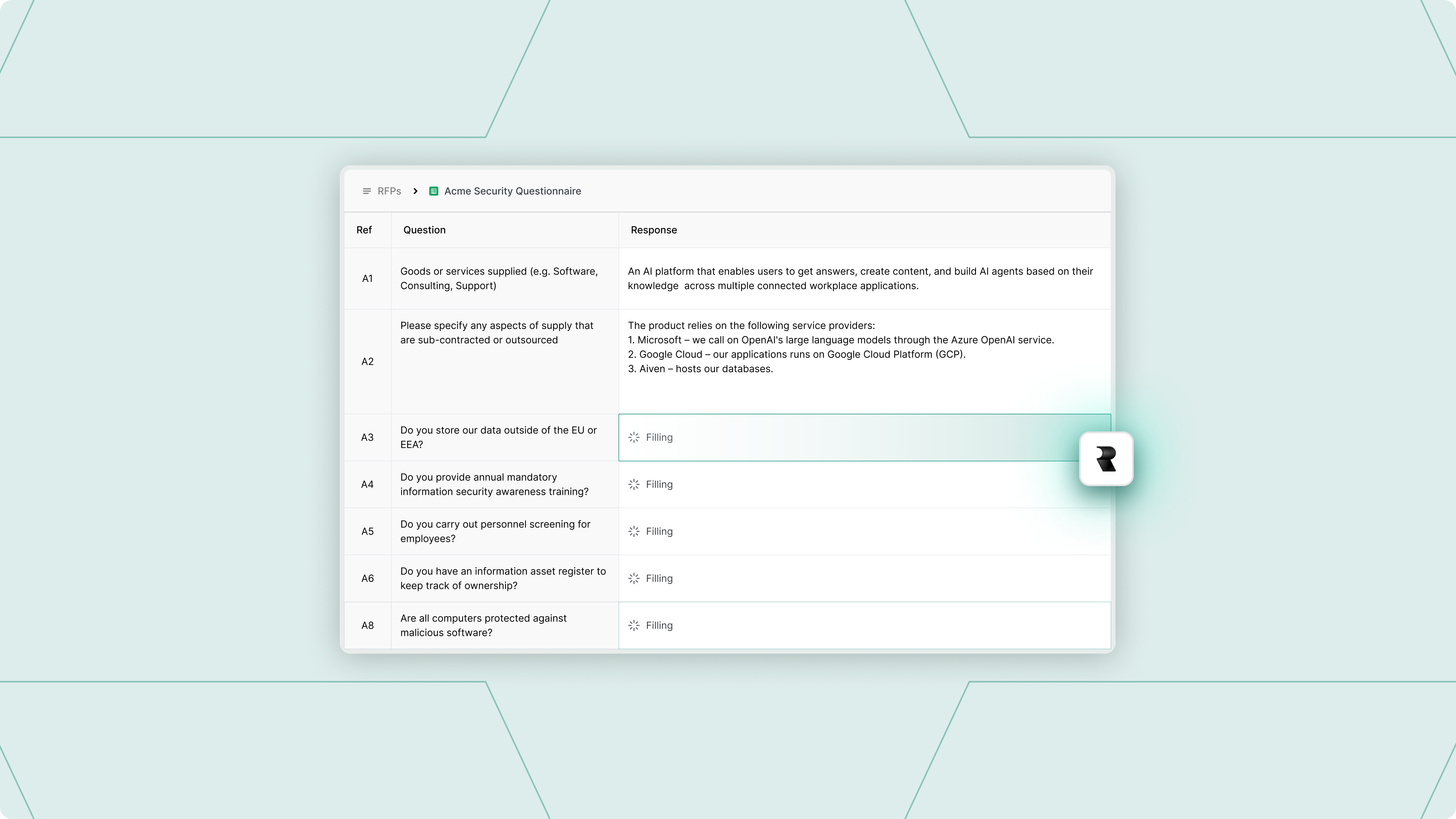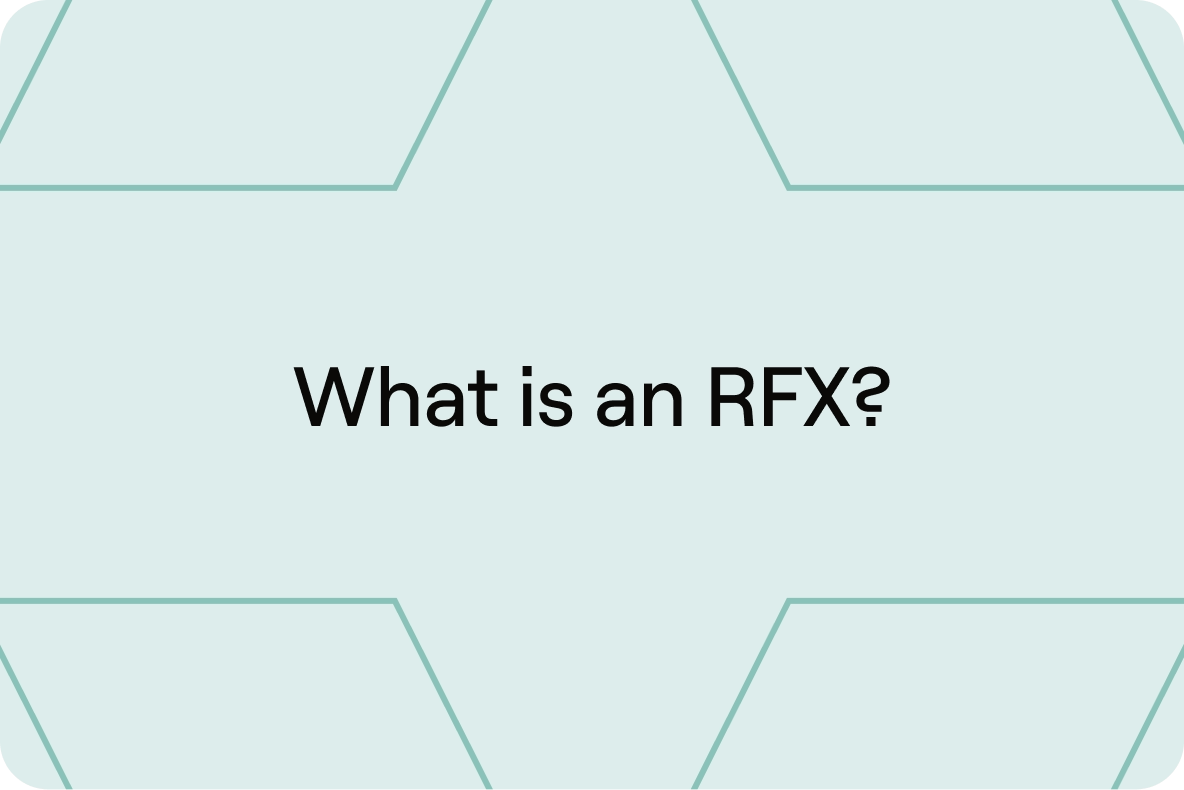The $5 million deal is on the line. Your sales team just qualified a massive enterprise opportunity, only to have the momentum stall when a 150-page document lands on your desk. It's filled with acronyms, and a dense matrix of requirements. The clock is ticking, and the wrong response means losing the deal and wasting hundreds of hours of highly paid sales and solutions engineering time.
This alphabet soup of formal vendor solicitation is collectively known as RFX.
Understanding what RFX means isn't just procurement trivia; it's the difference between responding to the right request with the right information, or wasting weeks on a misdirected proposal that never had a chance.
The thesis: RFX is the umbrella term for all formal vendor solicitation documents in procurement. Mastery of the RFX process (both issuing and responding) is no longer a back-office function; it's a core revenue competency. This guide breaks down the RFX meaning, dissects the critical differences between RFI, RFP, and RFQ, and provides the strategic playbook for winning.
What does RFX mean?
RFX stands for "Request for X," where X is a variable representing different types of vendor solicitation documents. It is the collective term for all formal, structured requests organizations send to potential suppliers when evaluating, sourcing, or purchasing products and services.
The "X" is a flexible placeholder that can represent:
- Information (RFI)
- Proposal (RFP)
- Quotation (RFQ)
- Tender (RFT)
- Bid (RFB)
- Solution (RFS)
RFX is primarily used in B2B procurement and revenue operations contexts when discussing sourcing strategy at a high level. The term allows procurement professionals to discuss the solicitation process without committing to a specific request type.
Crucially, RFX documents are formal, structured communications, not casual inquiries. They are designed to standardize vendor responses so that the buying organization can make objective, apples-to-apples comparisons.
So, when a Chief Revenue Officer asks, "Are we prepared to handle the RFX volume this quarter?" they are signaling a need for a robust, scalable process to manage all incoming formal requests, whether they are exploratory RFIs or complex RFPs.
Why RFXs are important for buyers and sellers
For strategic investments, the informal "chat with a vendor" approach is a liability. RFX documents exist because they create structure, fairness, and, most importantly, defensibility in vendor selection. This is especially critical for enterprises, regulated industries, and public sector organizations.
Here's why RFX documents are essential for both the issuer (buyer) and the responder (seller).
The anti-pattern: What happens when you skip the formal RFX process for a strategic purchase? You end up with "shadow IT," inconsistent vendor selection, decisions based on personal relationships rather than merit, and a lack of accountability when the project inevitably hits turbulence. For any purchase above a certain threshold (often $50K+ in large enterprises), the RFX process is mandated by internal policy to mitigate these risks.
RFI vs. RFP vs. RFQ: What's the difference?

While the RFX family is large, most procurement scenarios use one of three core types. Selecting the wrong type wastes time for everyone involved and signals a lack of maturity from the issuer.
1. Request for information (RFI)
The RFI is the discovery phase.
- Purpose: Gather general information about the market, vendors, products, or services without committing to a purchase. It's market research disguised as a document.
- When to use: You are exploring a new category, you don't know what solutions exist, or you need to pre-qualify vendors before issuing a full RFP.
- What vendors provide: Company background, product overviews, case studies, high-level capabilities, and rough pricing ranges (non-binding).
Real-world example: A Director of Revenue Operations is tasked with finding a new Sales Enablement platform. They issue an RFI to 15 vendors to understand: What features are standard? What integrations are available? Which vendors serve our industry size? The goal is education, not selection.
2. Request for proposal (RFP)
The RFP is the solution phase.
- Purpose: Solicit detailed, comprehensive proposals for complex purchases where solution fit, methodology, implementation approach, and vendor partnership matter as much as price.
- When to use: Complex projects with multiple requirements, strategic purchases requiring custom implementation, or multi-year contracts where you need to evaluate the vendor's approach to solving your problem.
- What vendors provide: Detailed solution descriptions, implementation methodology and timeline, team composition, references, and specific responses to technical and functional requirements.
Real-world example: A SaaS company needs to hire a RevOps consulting firm to overhaul their Salesforce instance and integrate their new marketing automation tool. They issue an RFP detailing their tech stack, challenges, and goals. Vendors respond with their diagnostic approach, recommended solutions, team structure, timeline, and pricing.
3. Request for quotation (RFQ)
The RFQ is the pricing phase.
- Purpose: Obtain specific, binding pricing for well-defined products or services when requirements are clear and standardized.
- When to use: Commodity or near-commodity purchases, when requirements are fully specified, and when price is the primary decision factor.
- What vendors provide: Itemized pricing, volume discounts, payment terms, delivery timelines, and warranty information.
-
Real-world example: A company buying 500 identical laptops with specific hardware specs would issue an RFQ. The specifications are non-negotiable; the decision comes down to the lowest price and best delivery terms.
A decision matrix: RFI vs. RFP vs. RFQ
The difference between RFI, RFP, and RFQ is the difference between discovery, solution, and transaction. Use this table to instantly determine the buyer's intent and allocate your resources correctly.
Other RFX types worth knowing
While RFI, RFP, and RFQ dominate, you may encounter these specialized types:
- Request for Tender (RFT): Essentially an RFP, commonly used in public sector procurement and outside North America. It emphasizes formal bidding processes.
- Request for Bid (RFB): Similar to an RFQ but often involves sealed bids opened simultaneously on a specific date. Common in construction and government contracts.
- Request for Qualifications (RFQ/RFQual): Focuses solely on vendor credentials, experience, and expertise rather than a specific project proposal. Often used to create a pre-approved list of service providers.
The typical RFX process

While the complexity varies, most enterprise RFX processes follow a similar multi-stage journey designed to ensure fair evaluation and optimal vendor selection.
The average enterprise RFP process takes 3 to 6 months from launch to contract signature. Speeding up this cycle is a major competitive advantage.
1. Planning and requirements gathering (2-4 weeks)
This is the most critical stage. Failure here guarantees failure later.
- Action: Define business needs, success criteria, and build the evaluation criteria and scoring methodology.
- Common failure point: Stakeholders disagreeing on requirements after the RFX is issued, leading to amendments and delays.
2. Document creation and issuance (1-2 weeks)
The procurement team drafts the RFX document, including requirements, questions, instructions, and the timeline.
- Action: Legal and procurement review the document.
- Pro tip: Ensure the document clearly states the evaluation criteria and the weight assigned to each section (e.g., Price = 30%, Technical Fit = 40%, Implementation Plan = 30%).
3. Vendor identification and outreach (1 week)
The buying organization researches and invites a shortlist of qualified vendors.
- Action: Distribute the RFX and host a mandatory vendor Q&A session to clarify ambiguities.
4. Vendor response period (2-6 weeks)
Vendors prepare and submit their responses. The timeline depends heavily on the complexity (an RFQ might take 2 weeks; a complex RFP might take 6).
- Action: Buying organization fields questions and issues formal amendments (if necessary).
- Common failure point: Vendors submitting non-compliant responses (e.g., missing mandatory sections or exceeding page limits).
5. Evaluation and shortlisting (4-6 weeks)
The cross-functional evaluation team scores responses against the pre-defined criteria.
- Action: Shortlist 2-5 finalists. Conduct demos, proof-of-concepts (POCs), and reference checks.
- Strategic insight: Inconsistent scoring across evaluators is a major source of bias and delay. Clear scoring rubrics are essential.
6. Selection and negotiation (2-4 weeks)
The winning vendor is selected, and final terms are negotiated.
- Action: Negotiate final pricing, service level agreements (SLAs), and contract terms.
- Pro tip: Notify unsuccessful vendors promptly and offer a debriefing session (this builds goodwill for future opportunities).
7. Award and contracting (1-2 weeks)
The contract is executed, and implementation begins.
How to respond to an RFXs
If you are on the revenue side, treating every RFX the same is a losing strategy. Your win rate is directly tied to your ability to qualify hard, tailor strategically, and respond with precision.
Step 1: Qualify ruthlessly
Before you commit 40+ hours of team time, you must determine if the RFX is winnable.
If you cannot answer these questions confidently, walk away. A strategic "No" saves resources for a winnable "Yes."
Step 2: Response best practices
Once qualified, execution must be flawless.
- Read instructions carefully: Many RFPs disqualify non-compliant responses immediately. Pay attention to formatting, file types, and page limits.
- Answer the question asked: Don't provide generic marketing copy. If they ask about your disaster recovery plan, provide the technical details, not a high-level assurance.
- Be specific and evidenced: Use customer examples, metrics, and concrete details. Instead of saying, "Our solution is fast," say, "Our solution reduced average response time by 42% for Customer X."
- Make it scannable: Evaluators review dozens of responses. Use headers, tables, bullet points, and bold text to guide their eyes to the most important information.
The efficiency insight: At Realm, we see sales and solutions engineering teams spending 20 to 40 hours on a single, complex RFP response. This is time that could be spent selling, strategizing, or closing other deals. The companies that win consistently are those that minimize this administrative burden.
Automate RFX responses with Realm

Realm is designed to streamline your entire response process, including RFPs, RFIs, RFQs, and security questionnaires such as VSQs, CAIQs, SIGs, DDQs. By connecting directly to your company's existing knowledge base, Realm's AI agents can automate up to 80% of your response drafting, allowing your team to focus on review and strategic customization.
7 steps to automate RFX responses
Realm provides a centralized platform for managing the entire bidding process, from initial upload to final submission.
1. Upload the questionnaire
Start by uploading the unfilled RFX or questionnaire file directly to the Realm platform. Realm supports diverse file formats, including Excel, PDF, and Word.
2. Analysis and parsing
Realm automatically analyzes the document, recognizing which questions, columns, or tables require a response. The system breaks the RFP down into manageable sections for processing.
3. Choose your AI agent
You can set up specialized AI Agents for different question types, product verticals, or customer segments. Each Agent can be grounded in a specific subset of your knowledge base to ensure the most relevant information is used.
4. Automate drafting
Realm drafts comprehensive, accurate, and compelling responses in your company’s language and tone of voice. Every answer is grounded in your company’s verified knowledge base, including past winning proposals. To ensure accuracy and easy verification, Realm cites the sources it references for every generated answer. This process prevents AI "hallucinations" by only using your approved, factual content.
5. Review and collaborate
AI drafts are complete in minutes, you can seamlessly review and finalize the responses with your team. You can manually edit the answer, approve it if it's final, or write a follow-up prompt asking the AI for edits or additions. You can also assign specific questions or sections to subject-matter experts (SMEs) for finalization.
6. Export and submit
Once all answers have been reviewed and approved, you can export the finalized document. The exported file will maintain the exact structure and formatting of the original RFP spreadsheet or document.
7. Repurpose winning responses'
After the RFP is completed and approved, the finalized responses are automatically added back into your knowledge base under a source called “RFPs”. This ensures that future AI Agents will automatically draw on your latest winning answers, continually improving response quality and consistency.
Final thoughts on RFXs
Whether you are issuing RFX documents to find the perfect vendor or responding to them to win a strategic deal, understanding the nuances of each type (and executing the process efficiently) directly impacts your bottom line.
Key takeaways for revenue leaders:
- RFX is the umbrella term for formal vendor requests (RFI, RFP, RFQ).
- RFI is for discovery; RFP is for complex solutions; RFQ is for standardized pricing.
- The average RFX process takes 3-6 months, making speed a critical competitive factor.
- Qualification is paramount. Don't waste resources on unwinnable deals.
- AI is the new standard. Manual RFX response is rapidly becoming obsolete.
Companies that master RFX processes gain a measurable advantage. Issuers make better vendor decisions faster. Responders win more deals with less effort. If your team is still manually assembling 150-page proposals, you are losing time, money, and market share. It's time to start automating.
FAQ on RFXs
What does RFX stand for?
RFX stands for "Request for X," where X is a variable representing different types of procurement requests such as Information (RFI), Proposal (RFP), Quotation (RFQ), Tender (RFT), or Bid (RFB). It is the collective term for all formal vendor solicitation documents.
What's the difference between RFP and RFQ?
An RFP (Request for Proposal) solicits detailed proposals for complex purchases where solution approach, methodology, and vendor capabilities matter. An RFQ (Request for Quotation) requests specific, binding pricing for well-defined products or services where requirements are standardized and price is the primary decision factor.
How long does an RFX process typically take?
Most enterprise RFX processes take 3-6 months from initial planning to contract execution. This includes time for document creation, vendor responses (2-6 weeks), evaluation (4-6 weeks), and negotiation/contracting.
Do I need an RFI before issuing an RFP?
Not always. If you already understand the market, have clear requirements, and know potential vendors, you can skip directly to an RFP. However, an RFI is highly valuable when you're exploring new categories, unclear on available solutions, or need to pre-qualify a large pool of vendors.
Can AI really help with RFP responses?
Yes. AI-powered tools like Realm can automate 60-80% of RFP response drafting by analyzing your content library, finding relevant answers, and generating tailored, accurate responses. This dramatically reduces the time spent on initial drafting and allows sales teams to focus on strategy and personalization.
What makes a winning RFP response?
Winning responses are compliant (follow all instructions), specific (use real examples and data), tailored (address the issuer's unique needs), and differentiated (clearly explain why you are the best choice). Generic, copy-paste responses rarely succeed.


